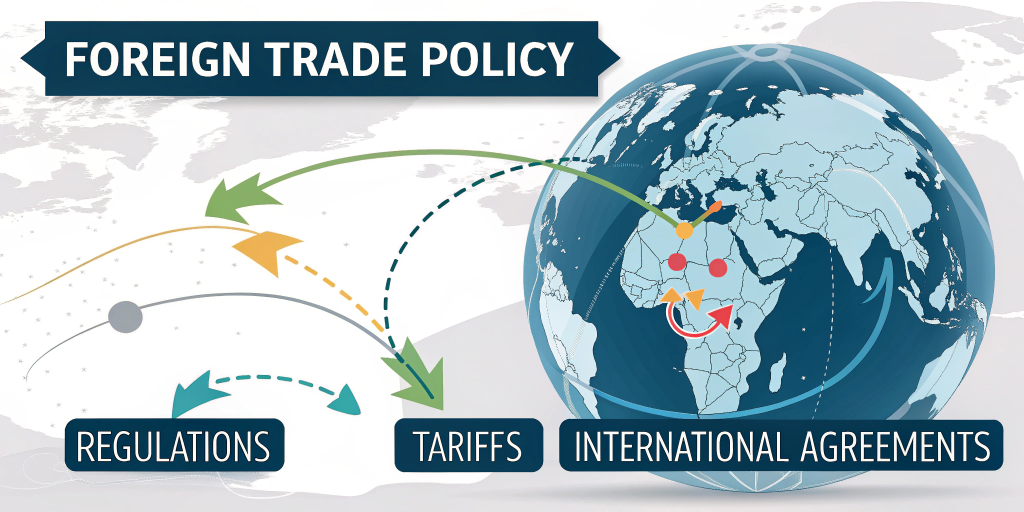Understanding the meaning of foreign trade policy is not just a matter of knowledge; it is a key to grasping how a country interacts with the global market. In simple words, a foreign trade policy lays out the rules and ideas that guide a nation’s import and export activities. This article will explore the meaning and importance of a foreign trade policy, focusing on India’s policy. We will discuss what the policy aims to achieve, its main features, and the challenges it faces. As you read through, imagine a friendly chat where complex ideas are broken down into simple, easy-to-follow stories, just like a conversation with a knowledgeable friend who simplifies complex topics for you.
Definition of Foreign Trade Policy
At its core, a foreign trade policy sets the guidelines for how a nation engages in trade beyond its borders. When we talk about foreign trade policy, we refer to a government’s plan to manage the exchange of goods and services with other countries. This policy includes rules, procedures, and incentives to support exports and regulate imports.
For example, consider a small shop that sells handmade crafts to people in another country. The shop benefits from government policies that simplify exporting goods. In this way, a foreign trade policy acts like a hidden helper, aiming to boost trade and improve economic relationships.
Importance of Foreign Trade Policy
A good foreign trade policy serves several vital roles. It helps create a fair trading environment, supports and uplifts domestic industries, and strengthens economic ties with other countries. This support for local businesses is a key reason why foreign trade policies are vital. It’s not just about trade, it’s about fairness and equality in the global market.
- Boosting Exports: Simplified rules and incentives are not just theoretical concepts; they are practical tools that encourage businesses to sell their products abroad. This is a key role of foreign trade policy, which directly impacts the economy. It’s about more than just selling goods, it’s about expanding horizons and growing the economy.
- Economic Growth: Increased trade can lead to higher national income and job creation.
- Trade Competitiveness: A clear policy helps local companies compete globally. It’s not just about trade; it is about recognition and success in the global market.
- Market Stability: By managing imports and exports, the policy can help prevent sudden market disruptions.
Statistics show that countries with well-structured trade policies often experience more sustainable growth. For instance, economies with streamlined export procedures tend to see annual export growth rates of around 5% to 10% (World Trade Organization, 2022).
Objectives of India’s Foreign Trade Policy
India’s Foreign Trade Policy has a number of objectives designed to support the country’s economic ambitions. At its heart, the policy aims to:
- Boost Exports: One main goal is to increase the amount of goods and services that India sells abroad. More exports mean more income for local businesses.
- Facilitate Economic Growth: By promoting international trade, India hopes to jump-start economic progress. This includes attracting investment and creating new jobs.
- Enhance Trade Competitiveness: India wants to make its products more desirable in the global market. Better quality, innovation, and effective marketing are key focuses.
- Diversify Trade Partnerships: Increasing the number of international trade partners can help stabilise the economy during global market fluctuations.
Each of these objectives is designed to make India more competitive and prosperous on the world stage.
Boosting Exports
Export growth is a cornerstone of India’s trade policy. Policies are implemented to help businesses of all sizes expand their markets. The aim is to create an environment where local products can thrive internationally.
For example, government programs may offer tax benefits or provide easier access to shipping services. Recent figures reveal that India’s exports grew by about 12% in specific sectors last year (Economic Times, 2023). Such progress is a direct result of policies that ease export procedures and support businesses in reaching new markets.
Economic Growth Facilitation
Economic growth is not just about numbers; it is about creating opportunities for people. India’s foreign trade policy ensures that the benefits of increased trade extend to all parts of society. By promoting exports, the policy helps generate jobs, increases national revenue, and ultimately lifts living standards. This is the policy’s broader impact, which goes beyond trade numbers.
Data from the Ministry of Commerce indicates that exports can contribute up to 15% of India’s overall GDP growth (Ministry of Commerce, 2023). As public revenue increases, this improvement in the economy often leads to better infrastructure, education, and healthcare systems.
Enhancing Trade Competitiveness
Staying competitive in the global market is a key challenge for any country. India’s foreign trade policy focuses on enhancing the quality and competitiveness of its products. Measures include investing in technology, improving compliance with global standards, and encouraging companies to innovate.
Improving product quality helps India win international contracts and builds a reputation for reliability. This strategic focus has led to a noticeable enhancement in India’s global trade rankings. According to a recent report by Business Standard, Indian products have become more competitive in markets such as Africa and Africa’s neighbors (Business Standard, 2023).
Key Features of India’s Foreign Trade Policy
India’s Foreign Trade Policy is a comprehensive document detailing the rules and benefits applicable to international trade. Here are some of the key features:
- Simplification of Procedures: Ongoing efforts aim to reduce red tape and bureaucratic delays.
- Incentives for Exporters: These include tax breaks, subsidies, and easier access to international markets.
- Monitoring Compliance: Regular audits and checks ensure that businesses adhere to global and domestic standards.
- Special Focus on Sectors: Based on global demand, specific sectors, such as textiles, pharmaceuticals, and IT, are prioritized.
These features create a framework that benefits domestic businesses and makes them more competitive overseas.
Overview of India’s 2023 Foreign Trade Policy, the latest version of the policy that sets the tone for India’s trade strategies in the coming years.
India’s 2023 Foreign Trade Policy is the latest version, building on previous efforts while introducing fresh ideas. This updated policy is designed to streamline export processes further, enhance competitiveness, and tap into new global markets.
The 2023 policy, which has been widely covered by top-performing articles and reports online, emphasizes four key pillars. It is a balanced approach that considers both current strengths and areas needing improvement.
Four Key Pillars of the 2023 FTP
The recent policy is built on four primary pillars that work together to boost the nation’s trade performance:
- Innovation and Technology: The policy encourages the use of modern technology in exporting processes. Businesses are pushed to adopt digital tools that make trade smoother and more secure.
- Market Diversification: Efforts are being made to explore new markets instead of relying only on traditional partners. This not only opens up new revenue streams but also reduces over-reliance on a few countries.
- Ease of Doing Business: Simplified procedures and reduced documentation aim to make the trading process smoother. This is particularly important for small and medium-sized businesses.
- Sustainability: A growing emphasis on green practices and sustainable production methods ensures that trade growth does not come at the environment’s expense.
Each pillar supports the overall goal of making India’s international trade more efficient and resilient.
Measures for Trade Facilitation
To put the policy into action, the government has introduced various measures for trade facilitation. These practical steps are designed to ease the movement of goods across borders and reduce delays at ports and checkpoints. Some of these measures include:
- Digital Documentation: Moving from paper to digital formats helps speed up the export process.
- One-Stop Clearance Systems: Simplifying the process so that businesses can get multiple approvals at a single counter.
- Enhanced Logistics Support: Collaborations with private companies to improve the speed and efficiency of shipping.
- Capacity Building: Training programs for small business owners to help them understand and navigate export procedures effectively.
These measures aim to reduce delays and costs, making it easier for businesses to sell their products overseas.
Recent Developments in India’s Foreign Trade Policy
In 2023 and beyond, several recent developments have marked a turning point for India’s trade policy. The government has set ambitious export targets and introduced new reforms. Some of these developments include:
- Revised Incentive Schemes: Updated grants and subsidies aimed at encouraging local industries to boost exports.
- Focus on Digital Economy: The integration of technology in trade has led to improved transparency and efficiency.
- New Trading Agreements: Efforts to secure new trade deals with emerging markets have also taken center stage.
- COVID-19 Recovery Measures: Specific measures were introduced to help industries recover from the disruptions caused by the pandemic.
These developments show a dynamic approach, where policymakers learn from past challenges and adapt to new market realities.
Authorities Responsible for Formulating Foreign Trade Policy
The formulation of India’s Foreign Trade Policy is a coordinated effort involving several key authorities. The central bodies responsible for this task include:
- Ministry of Commerce and Industry: This ministry plays a pivotal role in formulating, revising, and implementing the policy.
- Directorate General of Foreign Trade (DGFT): The DGFT is responsible for managing the day-to-day activities related to trade.
- State Governments: Regional authorities work in tandem with central government bodies to ensure that local industries benefit from the policy.
- Advisory Committees: These committees, made up of experts from various sectors, provide valuable insights and recommendations to shape the policy direction.
Each player contributes to creating a balanced and effective strategy that reflects both domestic needs and international challenges.
Export Targets for 2023
India has set ambitious export targets for 2023. These goals are part of the broader effort to boost economic growth and create jobs. Key targets include:
- Increased Export Revenue: Aiming for an export revenue growth of 12% to 15% across several key sectors.
- Expansion of High-Value Exports: Focusing on sectors like pharmaceuticals, engineering goods, and technology to drive higher margins.
- Diversification of Export Markets: Developing and entering new markets in Africa, Latin America, and Southeast Asia.
Statistical models and market research support such goals. Reports from organizations like the World Bank and the International Trade Centre have highlighted these targets as realistic yet challenging, given global market conditions.
Challenges in Implementing Foreign Trade Policy
Even well-crafted policies face challenges during implementation. Some of the main hurdles include:
- Bureaucratic Delays: Despite efforts to simplify processes, bureaucratic hurdles still sometimes cause delays.
- Infrastructure Issues: Outdated or insufficient transport and logistics infrastructure can hamper trade efficiency.
- Global Market Fluctuations: Trade policies can be affected by unforeseen global events and economic downturns.
- Compliance and Regulatory Issues: Ensuring that all businesses, especially small and medium enterprises, meet international standards can be a complex task.
Understanding these challenges helps policymakers tailor solutions that make the policy more effective and responsive to real-world problems.
Impact of Foreign Trade Policy on Economic Relations
The reach of a foreign trade policy extends well beyond export figures. It plays a crucial role in shaping international relations and economic stability. Here are some straightforward ways in which India’s foreign trade policy influences economic relations:
- Strengthening Bilateral Ties: As India ramps up trade with more countries, stronger diplomatic and economic ties are formed. This can lead to mutual benefits such as technology exchange and collaborative projects.
- Promoting Regional Integration: By aligning with regional trade bodies like the South Asian Association for Regional Cooperation (SAARC), India helps promote smoother economic interactions among neighboring countries.
- Encouraging Foreign Investments: A clear and effective trade policy can attract foreign investors who see stability and growth potential. This influx of capital boosts local industries and infrastructure projects.
- Balancing Trade Deficits: By focusing on exports and regulating imports, the policy helps maintain a healthier balance of payments—a key indicator of economic stability.
For instance, as reported by Business Standard and The Economic Times, diplomatic channels saw increased engagement after new trade measures were introduced in 2023. These developments underline that a robust foreign trade policy can connect different economies and lead to lasting, beneficial relationships.
Comparative Perspectives and Opinions
Different experts hold varied opinions on the effectiveness of India’s foreign trade policy. Some common perspectives include:
- Optimistic Views: Many believe that the latest reforms will significantly boost India’s global presence. Statistically, similar policy shifts in other countries have led to export growth of 10% or more in subsequent years.
- Critical Opinions: Others highlight that challenges such as bureaucratic inertia and infrastructure gaps may slow progress. They suggest that policy must be continuously monitored and adjusted.
- Balanced Outlook: Many experts agree that while the policy sets ambitious goals, its success depends on consistent implementation and supportive measures at all levels.
This kind of multi-angled analysis offers valuable insights. By listening to different voices, it is easier to understand both the strengths and areas needing improvement.
The Road Ahead: Opportunities and Realistic Expectations
Looking forward, the future of India’s Foreign Trade Policy holds several opportunities:
- Technology Integration: Continued adoption of digital tools can dramatically decrease export processing times and increase transparency.
- New Market Exploration: As the global economy shifts, there is significant room to capture new markets, especially in rapidly developing regions.
- Sustainable Practices: As the world focuses more on sustainability, policies that encourage eco-friendly production and trade practices are bound to gain more traction.
However, realistic expectations are equally important. While the goals are high, the challenges are real. Continuous collaboration between government bodies, industry stakeholders, and international partners will be crucial. Clear communication and support measures can help bridge the gap between policy intent and real-world outcomes.
Conclusion
In summary, the foreign trade policy encapsulates a comprehensive framework designed to boost international trade, aid economic growth, and improve global relations. India’s approach, mainly through its 2023 Foreign Trade Policy, reflects a commitment to innovation, market expansion, ease of doing business, and sustainability. The policy’s objectives—boosting exports, facilitating economic growth, and enhancing trade competitiveness—are supported by a clear set of guidelines, incentives, and recent reforms.
India’s policy focuses on technological advancement, market diversification, and simplified processes. It is geared toward overcoming domestic and international challenges. The set export targets and support mechanisms aim to propel the nation forward, while challenges such as bureaucratic delays and infrastructure issues remain areas for continuous improvement.
By learning from various perspectives and building on successful models from around the world, India’s Foreign Trade Policy offers a promising path toward stronger economic relationships and increased global competitiveness. This balanced approach, combining sound economic logic with achievable strategies, makes the policy an important topic for anyone interested in understanding how trade shapes our everyday lives.



